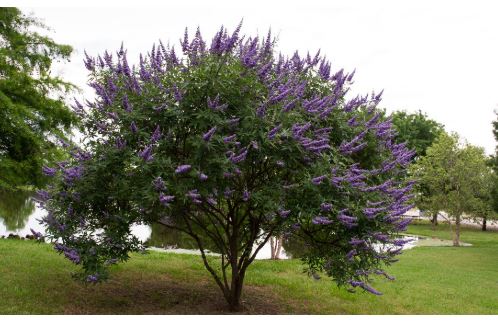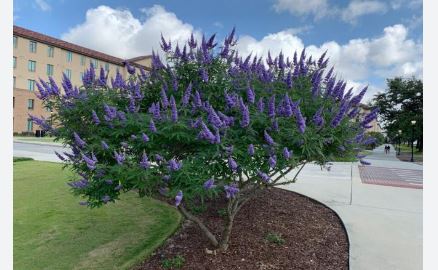
The Chaste Tree, scientifically known as Vitex agnus-castus, belongs to the Lamiaceae family, a group of aromatic plants that includes mint, lavender, and sage. The genus Vitex comprises about 250 species of trees and shrubs, primarily tropical, with V. agnus-castus being one of the most temperate-adapted. Its species name, “agnus-castus,” translates from Latin to “chaste lamb,” reflecting historical beliefs about its medicinal effects on chastity. Previously classified in the Verbenaceae family, molecular studies have placed it firmly in Lamiaceae, aligning it with plants characterized by square stems, opposite leaves, and tubular flowers. This classification underscores its resilience and adaptability across diverse climates.
Vitex agnus-castus is a deciduous shrub or small tree, growing 8–20 feet (2.4–6 meters) tall and 10–15 feet (3–4.5 meters) wide, with a spreading, multi-stemmed habit. Its palmate leaves, resembling cannabis, are aromatic, gray-green, and composed of 5–7 lance-shaped leaflets, each 2–6 inches (5–15 cm) long, with a slightly fuzzy underside. From summer to early fall, it produces slender, upright flower spikes, 6–12 inches (15–30 cm) long, bearing dense clusters of fragrant, tubular flowers in shades of lavender, blue, pink, or white. Small, round, grayish fruits (drupes), 0.1–0.2 inch (3–5 mm), follow, often used in herbal remedies. Its airy foliage and vibrant blooms give it a delicate yet robust presence.
Chaste Tree is native to the Mediterranean region, southern Europe (from Spain to Greece), and western Asia, including parts of Turkey and the Middle East. It thrives in dry, rocky soils along riverbanks, coastal plains, and hillsides, favoring warm, sunny climates with moderate water. Widely cultivated for ornamental and medicinal purposes, it has naturalized in parts of the southeastern United States, Australia, and South Africa, occasionally becoming invasive in disturbed areas like Texas and Florida. Its adaptability to various soils and climates has made it a global garden staple, particularly in regions mimicking its Mediterranean origins.
Vitex agnus-castus is hardy in USDA zones 6b–9b, tolerating temperatures as low as -5°F (-20°C) for established plants, though young specimens may need protection below 10°F (-12°C). It thrives in warm, temperate climates with temperatures between 50°F and 90°F (10°C–32°C), ideal for Mediterranean, coastal, and southern U.S. regions. In zones 6b–7a, it may die back in winter but regrows from roots in spring. In colder zones (below 6b), it can be grown in containers and brought indoors, adapting to indoor conditions with bright light and reduced watering.
The Chaste Tree is a versatile ornamental in landscaping, prized for its fragrant flowers, attractive foliage, and long blooming season. Its shrubby form suits mixed borders, cottage gardens, or Mediterranean designs, where it adds height and color as a specimen plant or informal hedge. Planted in groups, it creates privacy screens or backdrops, attracting bees, butterflies, and hummingbirds, boosting biodiversity. It tolerates urban conditions, including heat and poor soils, making it ideal for streetscapes or parking lot islands. In smaller gardens or patios, it thrives in containers, with pruning to maintain size. Its deer resistance and drought tolerance enhance its appeal, though it should be placed thoughtfully to avoid invasiveness in sensitive ecosystems.

How To Grow And Care For Chaste Tree
Cultivating the Chaste Tree (Vitex agnus-castus) is rewarding for its vibrant flower spikes, aromatic foliage, and pollinator-friendly nature, making it a standout in temperate and Mediterranean gardens.
Light Requirements
Provide full sun, with at least 6–8 hours of direct sunlight daily, to ensure abundant flowering and sturdy growth. Chaste Tree thrives in bright, open conditions, mimicking its native Mediterranean habitats. Partial shade reduces blooms and promotes leggy growth, so prioritize sunny locations for optimal performance.
Soil Preferences
Plant in well-draining soil, such as loam or sandy loam, with a pH of 6.0–7.5. It tolerates a range of soils, including poor or rocky types, but prefers moderate fertility. Avoid waterlogged or heavy clay soils to prevent root rot; amend with compost or sand to improve drainage if needed.
Watering Needs
Water regularly during the first year to establish roots, providing 1–2 inches (2.5–5 cm) weekly. Once established, water every 10–14 days in summer, allowing soil to dry slightly between waterings, and reduce in winter. Drought-tolerant once mature, overwatering leads to weak growth or fungal issues, so monitor soil moisture carefully.
Temperature Range
Grow in USDA zones 6b–9b, where temperatures range from -5°F to 90°F (-20°C to 32°C). It withstands brief freezes but may die back in zones 6b–7a, regrowing from roots in spring. In colder zones, cultivate in pots and move indoors during winter, maintaining above 40°F (4°C) with bright light and minimal water.
Humidity Levels
Chaste Tree thrives in moderate humidity (40–60%), typical of temperate climates. It tolerates low humidity but may suffer in high-humidity areas without good airflow, risking fungal diseases. Indoor plants need dry air in winter; avoid misting or humid rooms to prevent leaf or stem issues.
Container Selection
Choose pots with drainage holes to avoid water buildup. Plastic or ceramic pots, 18–24 inches (45–60 cm) wide, support its root system and spreading habit. Ensure the container is stable for its multi-stemmed growth, repotting every 2–3 years to refresh soil and accommodate expansion.
Fertilization
Apply a balanced, slow-release fertilizer (e.g., 10-10-10 NPK) in early spring to promote flowering and growth. Alternatively, use a liquid fertilizer monthly during spring–summer. Avoid over-fertilizing, as excess nitrogen reduces blooms and encourages leafy growth; skip feeding in fall and winter.
Pruning
Prune in late winter or early spring to shape the plant, remove dead wood, or encourage bushiness, cutting back by one-third with clean shears. Hard pruning to 1–2 feet (30–60 cm) promotes vigorous regrowth and larger flower spikes. Remove suckers to maintain a tree form if desired, ensuring airflow to prevent disease.
Propagation
Propagate via softwood cuttings or seeds. Take 4–6-inch (10–15 cm) cuttings in early summer, dip in rooting hormone, and plant in a well-draining mix; roots form in 4–6 weeks. Seeds, sown in spring at 65–75°F (18–24°C), germinate in 2–4 weeks but may not bloom true to parent. Cuttings are preferred for consistency.
Pest Control
Monitor for pests like aphids, spider mites, or whiteflies, which may target new growth or stressed plants. Inspect leaves and stems, treating infestations with insecticidal soap or neem oil in early morning. Maintain proper watering and prune for airflow to reduce pest risks, as healthy plants resist better.
Repotting
Repot container-grown Chaste Trees every 2–3 years in spring, or when roots outgrow the pot. Gently remove, trim dead roots, and replant in fresh, well-draining mix at the same depth. Water lightly after repotting and provide shade for a week to ease transplant shock, ensuring excellent drainage.
Winter Care
In zones 6b–7a, mulch the base with 2–3 inches (5–7.5 cm) of bark or straw to insulate roots during freezes. If dieback occurs, prune dead stems in spring, as roots often survive. Indoor plants need bright light, cool temperatures (40–50°F/4–10°C), and minimal watering to mimic dormancy.
Common Issues
Address overwatering (yellow leaves, root rot) by improving drainage and reducing frequency. Underwatering (wilting, leaf drop) requires slight watering increases. Poor flowering may result from insufficient sun or heavy pruning; adjust light or prune moderately. Fungal leaf spot from humidity is mitigated with better airflow and less overhead watering.